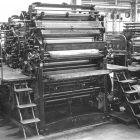Round-Down: Penguin Random House Launches Its New Website

It has been a little less than three years since the Penguin-Random House merger announcement was made, and the new company, Penguin Random House, just recently launched its new, joint website. The site is clean, highly functional, and features a home page that encourages engagement with PRH’s many excellent authors and titles. The house’s commitment to bridging the gap between readers and writers is apparent on the new site in this way; in addition, the site provides viewers with links to all of its social media profiles and the Penguin Random House blog.
In 2012, Penguin and Random House announced plans to merge, uniting as a huge, single force in the publishing world. In The New York Times’s coverage of this merging, Julie Bosman wrote that “[t]ogether, Penguin and Random House will make up the biggest and most dominant publisher in the business, one that has unmatched leverage against Amazon.com and the potential to inspire other mergers in the industry.” The two houses joined to become, as Penguin Random House CEO Markus Dohle put it, the first global trade-book publishing company. “One goal of the merger,” Bosman quotes Dohle, “is to ‘crack the code of discoverability’—of how to put books in front of potential buyers—‘in a world with fewer bookstores.’” When the news was announced in October 2012, it caused a stir in the literary community, with authors, editors, and agents all wondering how, exactly, the change would look.
Penguin and Random House made a point to note, when the news of their merging broke, that the change would be slow, that it would not be a sudden and intense jolt to the world of book publishing. Still, the few years since the announcement and subsequent merge have been like a held breath, with all waiting for the new publishing force to move online. The three-year waiting period for this seems to my mind proof of the care taken throughout the merger–the light but firm pressure applied to the companies in the effort to make a new publishing house from two major houses with outstanding reputations. What might seem a kind of lag in the move to the online space has actually been a calculated period of transition–one that, with the publishing industry’s often necessary few-years-long production cycles, really required a period of waiting.
At Publisher’s Weekly, Calvin Reid covered the merged house’s recent move online. There, Dohle says that the site is “consumer-focused.” And this really seems to be the case–the site offers a lot to those interested in buying books or staying up to date on the house’s activity–the Penguin Random House newsletter is marketed alongside bestselling and award-winning books, new releases, and upcoming titles.
Penguin Random House released a promotional Vine several days ago, and posted it to its social media accounts. The short video presents the text “It’s never been easier to get lost in our books” before cutting to a still of many book covers that then rearrange themselves to form the new Penguin Random House website itself. The suggestion here is that the new site is actually made from its books, and, further, that Penguin Random House highly values its titles and readers. It’s an impressively clean start for the publishing house. Watch the Vine here.
PRH’s new life on the web should, from the look of it, only help in the brand’s growth as it moves forward in an industry with a fast-changing landscape.



